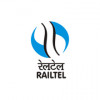Filter interviews by
Railtel Corporation Of India Network Engineer Interview Questions, Process, and Tips
Railtel Corporation Of India Network Engineer Interview Experiences
2 interviews found
(2 Questions)
- Q1. What is switch and it's working
- Ans.
A switch is a networking device that connects devices within a local area network (LAN) and forwards data packets between them.
Switch operates at the data link layer of the OSI model
It uses MAC addresses to forward data to the correct destination
Switches increase network performance by reducing collisions and segmenting traffic
Examples of switches include Cisco Catalyst series, Juniper EX series, etc.
- Q2. What is router and it's working
- Ans.
A router is a networking device that forwards data packets between computer networks. It operates at the network layer of the OSI model.
Routes data packets between different networks
Uses IP addresses to determine where to send data packets
Helps in creating and maintaining a network topology
Can be configured with access control lists to control traffic flow
Skills evaluated in this interview
I applied via Monster and was interviewed in Sep 2022. There were 2 interview rounds.

(2 Questions)
- Q1. What is STP, explain it ?
- Ans.
STP stands for Spanning Tree Protocol. It is a network protocol that prevents loops in a network topology.
STP is used to prevent broadcast storms and network loops.
It works by creating a logical tree structure of the network, with one root bridge and multiple branches.
STP blocks redundant links to prevent loops, but can activate them if the primary link fails.
STP has different versions, including RSTP and MSTP, which o...
- Q2. How many hosts in /29 subnet mask?
- Ans.
A /29 subnet mask allows for 6 usable hosts.
/29 subnet mask has 3 bits for host addresses
2^3 - 2 = 6 usable hosts
The first and last addresses are reserved for network and broadcast respectively
Interview Preparation Tips
Hhhhhhhhhhhhhh
Skills evaluated in this interview
Top trending discussions






Interview questions from similar companies

I applied via Referral and was interviewed before Feb 2017. There was 0 interview round.
Interview Preparation Tips
Having certifications make a huge difference to stand out in the crowd
Skills: Wireless Communication, Cisco Certified Network Professional (CCNP)
Duration: 1-4 weeks

I appeared for an interview in Jul 2017.
Interview Questionnaire
1 Question
- Q1. What is your favorite day
- Ans.
My favorite day is Sunday because it's a day of relaxation and spending time with loved ones.
I enjoy sleeping in and having a leisurely breakfast on Sundays.
I like to spend time outdoors or engage in hobbies on Sundays.
Sunday is a day for family gatherings and quality time with loved ones.
Interview Preparation Tips
Experience: Any thoughts
Tips: No
Round: Test
Experience: Any thoughts
Tips: No
Total Questions: 20
Round: Test
Experience: No
Tips: No
Duration: 1 hour
Total Questions: 20

I applied via Campus Placement and was interviewed before Jan 2021. There were 3 interview rounds.
Interview Questionnaire
2 Questions
- Q1. What are he layers of the OSI model?
- Ans.
The OSI model has 7 layers that define how data is transmitted over a network.
Layer 1: Physical - deals with the physical connection of devices
Layer 2: Data Link - responsible for error-free transfer of data between devices
Layer 3: Network - handles routing of data between different networks
Layer 4: Transport - ensures reliable delivery of data between applications
Layer 5: Session - establishes and manages connections ...
- Q2. There are seven layers in OSI model
- Ans.
Yes, there are seven layers in the OSI model.
The seven layers are: Physical, Data Link, Network, Transport, Session, Presentation, and Application.
Each layer has a specific function and communicates with the layers above and below it.
The OSI model is used to standardize communication between different computer systems.
Examples of protocols that operate at each layer include Ethernet at the Data Link layer and HTTP at t
Interview Preparation Tips
Skills evaluated in this interview

I applied via Naukri.com and was interviewed before Jan 2024. There were 5 interview rounds.
(1 Question)
- Q1. Normal question
(1 Question)
- Q1. Profile question
(1 Question)
- Q1. Profile question
(2 Questions)
- Q1. Salary discussion
- Q2. Salary discussion
(1 Question)
- Q1. Offere letter release

(1 Question)
- Q1. Technical questions such as VLAN, Routing and Firewalls
(1 Question)
- Q1. How the team collaboration to improve business.
(1 Question)
- Q1. Company details and salary negotiation.
Interview Preparation Tips
As a experienced, go through more technical and scenario based questions.

I applied via Naukri.com and was interviewed in Mar 2021. There were 3 interview rounds.
Interview Questionnaire
1 Question
- Q1. Thorough knowledge on networking like how TCP/IP works, TCP, IP packet header and each field importance, l2 and l3 protocols, Also some product level knowledge.
Interview Preparation Tips

I applied via LinkedIn and was interviewed in Aug 2023. There were 4 interview rounds.

Basic programs in c or c++, includes strings,
(1 Question)
- Q1. Data structures, operating system, dbms
(1 Question)
- Q1. All questions related to resume

(2 Questions)
- Q1. Basics Electronics questions
- Q2. What is conductor, capacitor, resistor..
- Ans.
Conductor, capacitor, and resistor are basic components used in electronic circuits.
Conductor: Allows the flow of electric current. Example: Copper wire.
Capacitor: Stores and releases electrical energy. Example: Ceramic capacitor.
Resistor: Limits the flow of electric current. Example: Carbon film resistor.
Interview Preparation Tips
Railtel Corporation Of India Interview FAQs
Tell us how to improve this page.
Railtel Corporation Of India Interviews By Designations
- Railtel Corporation Of India Field Engineer Interview Questions
- Railtel Corporation Of India Network Engineer Interview Questions
- Railtel Corporation Of India Engineer Interview Questions
- Railtel Corporation Of India Deputy Manager - Finance Interview Questions
- Railtel Corporation Of India RF Engineer Interview Questions
- Railtel Corporation Of India Network Administrator Interview Questions
- Railtel Corporation Of India District Manager Interview Questions
- Railtel Corporation Of India Project Engineer Interview Questions
- Show more
Interview Questions for Popular Designations
- Network Administrator Interview Questions
- Senior Network Engineer Interview Questions
- Network Support Engineer Interview Questions
- L2 Network Engineer Interview Questions
- Network Engineer L1 Interview Questions
- Network Security Engineer Interview Questions
- Network Specialist Interview Questions
- Network Analyst Interview Questions
- Show more
Railtel Corporation Of India Network Engineer Interview Process
based on 2 interviews
Interview experience
Network Engineer Interview Questions from Similar Companies
Railtel Corporation Of India Network Engineer Reviews and Ratings
based on 38 reviews
Rating in categories
|
Network Engineer
316
salaries
| ₹1.4 L/yr - ₹5.5 L/yr |
|
Field Engineer
118
salaries
| ₹2.1 L/yr - ₹4.8 L/yr |
|
Graduate Engineer
88
salaries
| ₹2.7 L/yr - ₹4.9 L/yr |
|
Network Engineer L1
58
salaries
| ₹2.4 L/yr - ₹6.2 L/yr |
|
Marketing Executive
45
salaries
| ₹4 L/yr - ₹6 L/yr |

Sterlite Technologies

Indus Towers

Cisco

BT Business
- Home >
- Interviews >
- Railtel Corporation Of India Interview Questions >
- Railtel Corporation Of India Network Engineer Interview Questions












